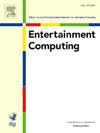用基于位置的增强现实游戏设计代表远程位置
IF 2.4
3区 计算机科学
Q2 COMPUTER SCIENCE, CYBERNETICS
引用次数: 0
摘要
基于位置的增强现实游戏(lbarg)允许玩家与物理环境进行交互。本研究调查了lbarg中物理远程位置的表示以及位置共享玩家(LSP)位置的利用,以参与远程位置的游戏。我们确定了三种模式,即桌面,覆盖和窗口,将玩家的位置表示给另一个不在同一位置的玩家。基于这些模式,我们设计了一个LBARG来研究不同模式对空间存在和沉浸感的影响。我们招募了30名参与者(n=30)进行受试者内研究。每个参与者都经历了不同的表征模式,我们用定量和定性的方法来评估他们的体验。结果表明,游戏模式的选择显著影响了玩家的空间临场感。对于LBARG,我们还设计了一个游戏机制,专门使用远程位置的物理属性。定性研究结果强调,利用物理环境有助于连接偏远地区和人们。我们的发现可以指导未来的游戏设计师如何在lbarg中设计空间存在感和沉浸感。本文章由计算机程序翻译,如有差异,请以英文原文为准。
Representing remote locations with location-based augmented reality game design
Location-based augmented reality games (LBARGs) allow for interaction with the physical environment of a player. This research study investigates the representation of physically remote locations in LBARGs and the utilization of a location-sharing player’s (LSP) location to engage in gameplay in remote locations. We identified three modes, i.e., tabletop, overlay, and window, to represent a player’s location to another player not at the same location. Based on these modes, we designed a LBARG to study the impact of the different modes on spatial presence and immersion. We recruited 30 participants (n=30) for a within-subjects study. Each participant experienced the different representation modes and we evaluated their experience using quantitative as well as qualitative methods. The results show that the chosen game mode significantly impacts the players’ spatial presence. For the LBARG, we also designed a game mechanic that specifically used the physical properties of the represented remote location. The qualitative findings highlight that utilizing the physical environment helps to connect remote locations and people. Our findings can guide future game designers on how to design for spatial presence and immersion within LBARGs.
求助全文
通过发布文献求助,成功后即可免费获取论文全文。
去求助
来源期刊

Entertainment Computing
Computer Science-Human-Computer Interaction
CiteScore
5.90
自引率
7.10%
发文量
66
期刊介绍:
Entertainment Computing publishes original, peer-reviewed research articles and serves as a forum for stimulating and disseminating innovative research ideas, emerging technologies, empirical investigations, state-of-the-art methods and tools in all aspects of digital entertainment, new media, entertainment computing, gaming, robotics, toys and applications among researchers, engineers, social scientists, artists and practitioners. Theoretical, technical, empirical, survey articles and case studies are all appropriate to the journal.
 求助内容:
求助内容: 应助结果提醒方式:
应助结果提醒方式:


